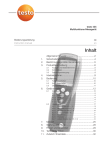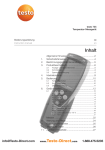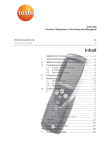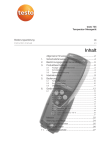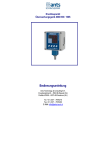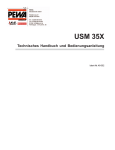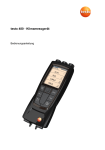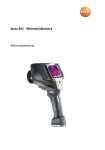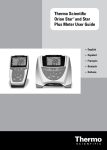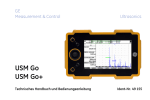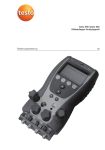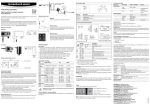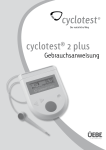Download Inhalt - Instrumart
Transcript
testo 635 Feuchte-/Temperatur- / Drucktaupunkt-Messgerät Bedienungsanleitung Instruction manual de en Inhalt 1. 2. 3. Allgemeine Hinweise ............................................2 Sicherheitshinweise ..............................................4 Bestimmungsgemäße Verwendung ......................5 Produktbeschreibung ..........................................6 3.1 3.2 3.3 4. 5. Inbetriebnahme ....................................................9 Bedienung..........................................................10 5.1 5.2 5.3 6. Anzeige- und Bedienelemente ........................................6 Schnittstellen ..................................................................8 Spannungsversorgung ....................................................8 Fühler anschließen ........................................................10 Ein- / Ausschalten ........................................................10 Displaybeleuchtung ......................................................11 Gerät einstellen ..................................................12 6.1 Konfigurationsmenü ......................................................12 6.1.1 6.1.2 6.1.3 6.1.4 6.1.5 6.2 Hauptmenü ..................................................................17 6.2.1 6.2.2 6.2.3 6.2.4 6.2.5 6.2.6 7. 8. 9. 10. 11. Profil................................................................................12 Einheiten ........................................................................13 Gerät ..............................................................................13 Fühler ..............................................................................14 Language ........................................................................16 Speicher (nur 635-2 ) ......................................................18 Messreihe (nur 635-2 )....................................................19 Mittelwert (nur 635-2) ....................................................20 Berechnung ....................................................................20 Material ..........................................................................22 Zyklisch Drucken (nur 635-1) ..........................................22 Messen ..............................................................23 Wartung und Pflege............................................26 Fragen und Antworten........................................27 Technische Daten ..............................................28 Zubehör / Ersatzteile ..........................................29 2 Allgemeine Hinweise Allgemeine Hinweise Dieses Kapitel gibt wichtige Hinweise zur Nutzung der vorliegenden Dokumentation. Diese Dokumentation enthält Informationen, die für einen sicheren und effizienten Einsatz des Produkts beachtet werden müssen. Lesen Sie diese Dokumentation aufmerksam durch und machen Sie sich mit der Bedienung des Produkts vertraut, bevor Sie es einsetzen. Bewahren Sie dieses Dokument griffbereit auf, um bei Bedarf nachschlagen zu können. Kennzeichnungen Darstellung Bedeutung Bemerkungen Warnhinweis: Warnung! Warnhinweis aufmerksam lesen und die genannten Vorsichtsmaßnahmen treffen! Schwere Körperverletzungen können eintreten, wenn die genannten Vorsichtsmaßnahmen nicht getroffen werden. Warnhinweis: Vorsicht! Warnhinweis aufmerksam lesen und die genannten Vorsichtsmaßnahmen treffen! Leichte Körperverletzungen oder Sachschäden können eintreten, wenn die genannten Vorsichtsmaßnahmen nicht getroffen werden. Gibt hilfreiche Tipps und Informationen. Nennt das Ziel, welches durch nachfolgend beschriebene Handlungsschritte erreicht wird. Bei nummerierten Handlungszielen die vorgegebene Reihenfolge beachten! Voraussetzung muss erfüllt sein, damit eine Handlung wie beschrieben ausgeführt werden kann. Handlungsschritte ausführen. Bei nummerierten Handlungsschritten die vorgegebene Reihenfolge beachten! Text erscheint auf dem Gerätedisplay. Taste drücken. Taste drücken. Nennt das Ergebnis eines vorangegangenen (Handlungs-)Schritts. Verweis auf weiterführende oder detailliertere Informationen. ±, 1, 2 Hinweis Handlungsziel Voraussetzung i, 1, 2, ... (Handlungs-)Schritt Text Displaytext Bedientaste Funktionstaste Resultat Querverweis Taste - º Beispiel: Funktion „Gerätedaten“ aufrufen Kurzschreibweise: Gerät ¬ (1) ¬ Ger.-Dat. ¬ (2) (3) OK OK (4) . en fr In diesem Dokument wird eine Kurzschreibweise verwendet, um Handlungsschritte (z. B. den Aufruf einer Funktion) darzustellen. es Kurzschreibweise de Allgemeine Hinweise 3 OK pt sv 4 Mit nl 3 Mit die Funktion Gerät wählen. Auswahl bestätigen. / die Funktion Ger.-Dat. wählen. Auswahl bestätigen. ?? 2 Mit / OK ?? 1 Mit it Erforderliche Handlungsschritte: 4 1. Sicherheitshinweise 1. Sicherheitshinweise Dieses Kapitel nennt allgemeine Regeln, die für einen sicheren Umgang mit dem Produkt unbedingt beachtet werden müssen. Personenschäden / Sachschäden vermeiden i Mit dem Messgerät und Fühlern nicht an oder in der Nähe von spannungs- führenden Teilen messen. i Das Messgerät / Messzellen nie zusammen mit Lösungsmitteln lagern, keine Trockenmittel verwenden. Produktsicherheit / Gewährleistungsansprüche wahren i Das Messgerät nur innerhalb der in den Technischen Daten vorgegebenen Parameter betreiben. i Das Messgerät nur sach- und bestimmungsgemäß verwenden. Keine Gewalt anwenden. i Handgriffe und Zuleitungen nicht Temperaturen über 70°C aussetzen, wenn diese nicht ausdrücklich für höhere Temperaturen zugelassen sind. Temperaturangaben auf Sonden / Fühlern beziehen sich nur auf den Messbereich der Sensorik. i Das Messgerät nur öffnen, wenn dies zu Wartungs- oder Instandhaltungszwecken ausdrücklich in der Dokumentation beschrieben ist. Nur Wartungs- und Instandsetzungsarbeiten durchführen, die in der Dokumentation beschrieben sind. Dabei die vorgegebenen Handlungsschritte einhalten. Aus Sicherheitsgründen nur Original-Ersatzteile von Testo verwenden. Fachgerecht entsorgen i Defekte Akkus / leere Batterien an den dafür vorgesehenen Sammelstellen abgeben. i Produkt nach Ende der Nutzungszeit an Testo senden. Wir sorgen für eine umweltschonende Entsorgung. en Bestimmungsgemäße Verwendung In folgenden Bereichen darf das Produkt nicht eingesetzt werden: · In explosionsgefährdeten Bereichen. · Zu diagnostischen Messungen im medizinischen Bereich it pt sv Das Produkt wurde für folgende Aufgaben / Bereiche konzipiert: · Raumklimamessung · Einregeln und Prüfen von raumluft-technischen Anlagen · Messung des Drucktaupunkts in Druckluftsystemen nl Das testo 635 ist ein kompaktes Messgerät zur Messung von Temperatur, Feuchte und Drucktaupunkt. ?? Setzen Sie dass Produkt nur für die Bereiche ein, für die es konzipiert wurde. Im Zweifelsfall bitte bei Testo nachfragen. ?? Dieses Kapitel nennt die Anwendungsbereiche, für die das Produkt bestimmt ist. es fr 2. de 2. Bestimmungsgemäße Verwendung 5 6 3. Produktbeschreibung 3. Produktbeschreibung Dieses Kapitel gibt eine Übersicht über die Komponenten des Produkts und deren Funktionen. 3.1 Anzeige- und Bedienelemente Übersicht Infrarot-, USB-Schnittstelle Display (Beleuchtung zuschaltbar) Bedientasten Rückseite: Batterie- und Funkmodulfach, Haltemagnete Starke Magnete Beschädigung anderer Geräte! i Sicherheitsabstand zu Produkten einhalten, die durch Magnetismus beschädigt werden können (z. B. Monitore, Computer, Herzschrittmacher, Kreditkarten). Fühlerbuchse(n) Tastenfunktionen Taste Funktionen Funktionstaste (3x): Funktion ist abhängig von der aktuellen Tastenbelegung Anzeige der 1. Messwertzeile wechseln Im Konfigurationsmodus: Wert erhöhen, Option wählen Anzeige der 2. Messwertzeile wechseln Im Konfigurationsmodus: Wert verringern, Option wählen Daten drucken Nur 635-1: Ist die Funktion Zyklisches Drucken aktiviert, wird die programmierte Messreihe gestartet Gerät einschalten, Displaybeleuchtung ein-/ausschalten; Gerät ausschalten (gedrückt halten) Start Ende M+ Mat Funk Wichtige Displayanzeigen Anzeige (blinkt) , Bedeutung Batteriekapazität (nur bei Akku-/Batteriebetrieb): · Im Batteriesymbol leuchten 4 Segmente: Batterie des Geräts ist voll · Im Batteriesymbol leuchten keine Segmente: Batterie des Geräts ist fast leer Druckfunktion: Daten werden an den Drucker gesendet Messkanal-Nr.: Kanal 1, Kanal 2. Handelt es sich bei einem Messkanal um einen Funk-Kanal, leuchtet zusätzlich zur Messkanal-Nr. das Funk-Symbol. en fr / Mittl Messr es ACT it / pt Hold Reset sv OK ESC nl Funktionen (Haupt-)Menü öffnen Eingabe bestätigen Abbrechen Messwert halten/Aktuellen Messwert anzeigen Max.-/Min-Werte auf aktuellen Messwert zurücksetzen Menüpunkt „Zeitliche Mittelwertbildung“ öffnen Menüpunkt „Messreihe“ öffnen (nur 635-2) Messreihe starten/beenden (nur 635-2) Werte speichern (nur 635-2) Menüpunkt „Material“ öffnen Menüpunkt „Funk“ öffnen ?? Taste ?? Funktionstasten (Belegung abhängig von Profil und Einstellung) de 3. Produktbeschreibung 7 8 3. Produktbeschreibung 3.2 Schnittstellen Infrarot-Schnittstelle Über die Infrarot-Schnittstelle an der Kopfseite des Geräts können Messdaten an einen Testo-Protokolldrucker gesendet werden. USB-Schnittstelle Über die USB-Schnittstelle an der Kopfseite des Geräts kann das Netzteil (Zubehör) zur Spannungsversorgung des Geräts angeschlossen werden. Geräte mit Speicher: Mess- / Gerätedaten können über die USB-Schnittstelle mit einem PC ausgetauscht werden. Das Messgerät ist ein HighPower-Gerät, evtl. ist ein zusätzlicher USB-Hub erforderlich! Fühlerbuchse(n) Über die Fühlerbuchse(n) an der Fußseite des Geräts können steckbare Messfühler angeschlossen werden. Funkmodul (Zubehör) Funkfühler dürfen nur in Ländern verwendet werden, in denen sie zugelassen wurden (siehe Anwendungshinweise zum Funkfühler). Über das Funkmodul können bis zu drei Funkfühler angeschlossen werden. 3.3 Spannungsversorgung Die Spannungsversorgung erfolgt über drei Mignon-Batterien (im Lieferumfang) bzw. -akkus bzw. über ein Netzteil (Zubehör). Das Laden von Akkus im Gerät ist nicht möglich. 1 Die beiden Schrauben auf der Rückseite des Geräts lösen und Batteriefachdeckel abnehmen. 2 Batterien / Akkus (3 x Mignon) in das Batteriefach einlegen. Polung beachten! 3 Funkmodul (Zubehör) in den Funkmodulschacht einschieben, bis dieses einrastet. Führungsnut beachten. 4 Batteriefachdeckel aufsetzen, andrücken und durch Anziehen der beiden Schrauben befestigen. en fr es it ² Batterien / Akkus und Funkmodul (Zubehör) einlegen: pt i Schutzfolie vorsichtig abziehen. sv Schutzfolie entfernen: ² Display-S nl Dieses Kapitel beschreibt die Handlungsschritte, die zur Inbetriebnahme des Produkts erforderlich sind. ?? Inbetriebnahme ?? 4. de 4. Inbetriebnahme 9 10 5. Bedienung 5. Bedienung Dieses Kapitel beschreibt die Handlungsschritte, die beim Einsatz des Produkts häufig ausgeführt werden. 5.1 Fühler anschließen Steckbare Fühler Steckbare Fühler müssen vor dem Einschalten des Messgeräts angeschlossen werden, damit diese vom Messgerät erkannt werden. i Anschlussstecker des Fühlers in die Fühlerbuchse des Messgeräts stecken. Funkfühler Funkfühler dürfen nur in Ländern verwendet werden, in denen sie zugelassen wurden (siehe Anwendungshinweise zum Funkfühler). Zur Verwendung von Funkfühlern ist ein Funkmodul erforderlich (Zubehör). Das Funkmodul muss vor dem Einschalten des Messgeräts angeschlossen werden, damit dieses vom Messgerät erkannt wird. Jeder Funkfühler besitzt eine Fühler-ID (Identifikationsnummer), diese muss im Konfigurationsmodus eingestellt werden. º Siehe Kapitel FÜHLER, S. 14. 5.2 Ein-/Ausschalten ² Gerät einschalten: i drücken. - Die Messansicht wird geöffnet: Der aktuelle Messwert wird angzeigt bzw. ---- leuchtet, wenn kein Messwert verfügbar ist. Geräte mit Speicher: Der aktivierte Messort wird angezeigt (oberste Zeile). -o oderGerät wird zum ersten Mal eingeschaltet, ein Reset wurde durchgeführt oder die Spannungsversorgung war für längere Zeit unterbrochen: - Funktion Language wird geöffnet. º Siehe Kapitel LANGUAGE, S. 16. i drücken. en fr es it Das Gerät ist eingeschaltet. pt ² Displaybeleuchtung ein- / ausschalten: sv 5.3 Displaybeleuchtung nl gedrückt halten (ca. 2s), bis das Display erlischt. ?? i ?? ² Gerät ausschalten: de 5. Bedienung 11 12 6. Gerät einstellen 6. Gerät einstellen Dieses Kapitel beschreibt die Handlungsschritte, die zur Anpassung des Messgeräts an spezielle Messaufgaben erforderlich sind. 6.1 Konfigurationsmenü Im Konfigurationsmenü werden die Grundeinstellungen des Messgeräts vorgenommen. ² Konfigurationsmenü öffnen: Das Gerät befindet sich in der Messansicht. gedrückt halten (ca. 2s) bis Konfig. angezeigt wird. i Mit gelangen Sie jeweils eine Menüebene zurück. Zum Verlassen des Konfigurationsmenüs ESC mehrfach drücken, bis das Gerät zur Messansicht gewechselt hat. ESC 6.1.1 Profil Das Gerät besitzt vordefinierte Messprofile, die auf spezielle Anwendungsgebiete zugeschnitten sind. Die Profileinstellung beeinflußt folgende Punkte im Messmodus: · Belegung der Funktionstasten · Anzahl der verfügbaren Funktionen · Struktur des Hauptmenüs Im Standardprofil sind alle Funktionen verfügbar. In den anwendungsspezifischen Messprofilen sind die verfügbaren Funktionen bedarfsgerecht reduziert, um einen schnelleren Zugriff zu gewährleisten. ² Profil einstellen: Das Konfigurationsmenü ist geöffnet, Konfig. wird angezeigt. 1 Profil ¬ 2 Mit OK / . gewünschtes Profil wählen und mit OK bestätigen. 6. Gerät einstellen 13 System US Individuelle Einstellmöglichkeiten °C hPa °F inchH2O °C, °F mbar, Pa, hPa, kPa, inchH2O ² Einheiten einstellen: Das Konfigurationsmenü ist geöffnet, Konfig. wird angezeigt. . 2 Mit / ISO/US (System-Einstellung) oder eine Messgröße (individuelle Einstellung) wählen und mit OK bestätigen. 3 Mit / das Einheitensystem bzw. die gewünschte Einheit einstellen und mit OK bestätigen. 6.1.3 Gerät ?? nl sv pt OK Gerätedaten ?? 1 Einheiten ¬ fr System ISO Temperatur Druck es Messgröße it Vordefinierte Systeme und individuelle Einstellmöglichkeiten: en de 6.1.2 Einheiten ² Gerätedaten anzeigen: Das Konfigurationsmenü ist geöffnet, Konfig. wird angezeigt. ¬ Ger.-Dat. ¬ OK . - Die Firmware-Version und die Seriennummer des Geräts werden angezeigt. 1 Gerät ¬ OK Datum / Uhrzeit ² Datum / Uhrzeit einstellen: Das Konfigurationsmenü ist geöffnet, Konfig. wird angezeigt. ¬ Dat./Zeit ¬ OK . 2 Mit / den Wert für Jahr einstellen und mit OK bestätigen. 3 Die weiteren Werte wie in Handlungsschritt 2 beschrieben einstellen. 1 Gerät ¬ OK 14 6. Gerät einstellen Batterietyp Um eine korrekte Anzeige der Batteriekapazität zu gewährleisten, muss der verwendete Batterietyp eingestellt werden. ² Batterietyp einstellen: Das Konfigurationsmenü ist geöffnet, Konfig. wird angezeigt. 1 Gerät ¬ 2 Mit OK / ¬ Bat-Typ ¬ OK . Batterie oder Akku wählen und mit OK bestätigen. Auto OFF Ist Auto OFF eingeschaltet, schaltet sich das Gerät nach 10min ohne Tastenbetätigung automatisch aus. Ausnahme: Zyklisches Drucken (Geräte ohne Speicher) bzw. ein Messprogramm (Geräte mit Speicher) ist aktiv. ² Auto OFF ein- / auschalten: Das Konfigurationsmenü ist geöffnet, Konfig. wird angezeigt. 1 Gerät ¬ 2 Mit OK / ¬ Auto OFF ¬ OK . Ein oder Aus wählen und mit OK bestätigen. Reset Beim Durchführen eines Resets wird das Gerät auf die Werkseinstellungen zurückgesetzt, alle Einstellungen / Daten werden gelöscht. Ausnahme: Sprache, Datum / Uhrzeit. ² Reset durchführen: Das Konfigurationsmenü ist geöffnet, Konfig. wird angezeigt. 1 Gerät ¬ 2 Mit OK ¬ Reset ¬ OK . Reset durchführen oder mit OK ESC abbrechen. 6.1.4 Fühler Funk Funkfühler dürfen nur in Ländern verwendet werden, in denen sie zugelassen wurden (siehe Anwendungshinweise zum Funkfühler). Zur Verwendung von Funkfühlern ist ein Funkmodul erforderlich (Zubehör). Das Gerät kann mit maximal drei Funkfühlern eine Verbindung herstellen. Wurden keine Funkfühler gefunden, kann dies folgende Ursachen haben: · Der Funkfühler ist nicht eingeschaltet oder die Batterie des Funkfühlers ist leer. · Der Funkfühler befindet sich außerhalb der Reichweite des Messgeräts. · Störquellen beeinflussen die Funkübertragung (z. B. Stahlbeton, Metallgegenstände, Wände oder andere Barrieren zwischen Empfänger und Sender, andere Sender gleicher Frequenz, starke elektromagnetische Felder). i Falls erforderlich: Mögliche Ursachen für die Störung der Funkübertragung beseitigen. Alternativ ist auch eine manuelle Eingabe der Fühler-ID möglich. i MAN ¬ Mit / die Fühler-ID eingeben. 3 Mit / den Fühler wählen, der der gewählten Kanal-Nr. zugeordnet werden soll. 4 Angezeigter Funkfühler mit OK der gewählten Kanal-Nr. zuordnen. Abgleich Feuchtefühler Die Funktion ist nur verfügbar, wenn ein Feuchtefühler gesteckt ist. Die Abgleichwerte können auf die Werkseinstellungen zurückgesetzt werden (Reset). Ein 2-Punkt-Abgleich kann durchgeführt werden. en fr es it werte pro Sekunde eingestellt (siehe Anwendungshinweise zum Funkfühler). 1 Fühler ¬ OK ¬ Funk ¬ OK . 2 Mit / die gewünschte Kanal-Nr. für den Funkfühler wählen (F.1, F.2 oder F.3) und mit OK bestätigen. - Das Gerät sucht nach eingeschalteten Funkfühlern im Empfangsbereich. - Die Fühler-ID der gefundenen Funkfühler wird angezeigt. pt Der Funkfühler ist eingeschaltet und die Übertragungsrate ist auf 2 Mess- sv Das Konfigurationsmenü ist geöffnet, Konfig. wird angezeigt. nl Ein Funkmodul (Zubehör) ist in das Gerät eingelegt. º Siehe Kapitel INBETRIEBNAHME, S. 9. ?? ² Funkfühler einrichten: ?? Jeder Funkfühler besitzt eine Fühler-ID (RF-ID). Diese besteht aus den letzten 3 Ziffern der Serien-Nr. und der Position des Schiebeschalters (H oder L) im Funkfühler. de 6. Gerät einstellen 15 16 6. Gerät einstellen ² Reset der Abgleichwerte durchführen: Das Konfigurationsmenü ist geöffnet, Konfig. wird angezeigt. ¬ Abgleich ¬ OK . 2 Mit / Reset wählen und mit 2x OK bestätigen. - Die Abgleichwerte werden auf die Werkseinstellungen zurückgesetzt. 1 Fühler ¬ OK ² Abgleich durchführen: Das Konfigurationsmenü ist geöffnet, Konfig. wird angezeigt. 1 Fühler ¬ OK 2 Mit 3 4 5 ¬ Abgleich ¬ OK . Abgleichpunkt P1 oder P2 wählen und mit 2x OK / bestätigen. Feuchtefühler in das Referenzmedium geben und Angleichzeit abwarten. Der aktuelle Feuchte-Messwert und der Abgleichpunkt (Sollwert) wird angezeigt. Mit OK das Abgleichmenü starten. Mit OK Abgleich speichern oder mit ESC abbrechen. Te-Typ Die im Gerät hinterlegte Fühlerkennlinie kann auf den verwendeten Fühlertyp eingestellt werden. ² Fühlertyp einstellen: Das Konfigurationsmenü ist geöffnet, Konfig. wird angezeigt. 1 Fühler ¬ OK 2 Mit / bestätigen. ¬ Te-Typ ¬ OK . den gewünschten Fühlertyp wählen und mit OK 6.1.5 Language ² Sprache einstellen: Das Konfigurationsmenü ist geöffnet, Konfig. wird angezeigt. 1 Language ¬ 2 Mit / . die gewünschte Sprache wählen und mit OK OK bestätigen. Menüübersicht testo 635-1 Profil Menüpunkte Funktion Standard Berechnung Berechnung Wassergehalt, Taupunkt, Feuchtkugeltemperatur, Differenztemperatur de-/aktivieren, Parameter „Alpha“ einstellen Materialkennlinie aktivieren Zyklisches Drucken de-/aktivieren Differenztemperatur de-/aktivieren Parameter „Alpha“ einstellen Berechnung Wassergehalt de-/aktivieren Berechnung Taupunkt de-/aktivieren Berechnung Psychometrische Temperatur de-/aktivieren Zyklisches Drucken de-/aktivieren Berechnung Wassergehalt, Taupunkt, Psychometrische Temperatur, Differenztemperatur de-/aktivieren, Parameter „Alpha“ einstellen Materialkennlinie aktivieren Zyklisches Drucken de-/aktivieren Material Funk Material Zykl. Drucken Delta Alpha H2OGehalt Taupunkt Psyc°C Zykl. Drucken Berechnung Material Zykl. Drucken en fr es it pt Der in diesem Kapitel beschriebene Weg zum Aufruf der Funktionen im Hauptmenü bezieht sind auf die Profil-Einstellung Standard. Ist ein anderes Profil eingestellt, so kann sich der Weg zum Aufruf einzelner Funktionen ändern bzw. die Funktion ist im eingestellten Profil nicht verfügbar. sv Die Profileinstellung beeinflußt die Anzahl der verfügbaren Funktionen und die Struktur des Hauptmenüs. nl Das Gerät besitzt vordefinierte Messprofile, die auf spezielle Anwendungsgebiete zugeschnitten sind. º Siehe Kapitel PROFIL, S. 12. ?? Im Hauptmenü werden Einstellungen vorgenommen, mit denen das Messgerät an die jeweile Messaufgabe angepaßt werden kann. ?? 6.2 Hauptmenü de 6. Gerät einstellen 17 18 6. Gerät einstellen Menüübersicht testo 635-2 Profil Menüpunkte Funktion Standard Speicher Messreihe Mittel Berechnung Messort aktivieren/anlegen, Protokolle drucken, Speicher löschen Messprogramm einstellen/de-/aktivieren Zeitliche/punktuelle Mittelwertbildung durchführen Berechnung Wassergehalt, Taupunkt, Psychometrische Temperatur, Differenztemperatur de-/aktivieren, Parameter „Alpha“ einstellen Materialkennlinie aktivieren Messort aktivieren/anlegen, Protokolle drucken, Speicher löschen Messprogramm einstellen/de-/aktivieren Zeitliche/punktuelle Mittelwertbildung durchführen Berechnung Wassergehalt, Taupunkt, Psychometrische Temperatur, Differenztemperatur de-/aktivieren, Parameter „Alpha“ einstellen Messort aktivieren/anlegen, Protokolle drucken, Speicher löschen Messprogramm einstellen/de-/aktivieren Zeitliche/punktuelle Mittelwertbildung durchführen Berechnung Wassergehalt, Taupunkt, Psychometrische Temperatur, Differenztemperatur de-/aktivieren, Parameter „Alpha“ einstellen Materialkennlinie aktivieren Material Funk Material Speicher Messreihe Mittel Berechnung Speicher Messreihe Mittel Berechnung Material ² Hauptmenü öffnen: Gerät befindet sich in der Messansicht. i drücken. - Menü wird angezeigt. Mit ESC gelangen Sie jeweils eine Menüebene zurück. Zum Verlassen des Hauptmenüs ESC mehrfach drücken, bis das Gerät zur Messansicht gewechselt hat. 6.2.1 Speicher (nur 635-2) Messort Der aktive Messort kann geändert werden. Es können max. 99 Messorte angelegt werden. Die nummerischen Messortbezeichnungen (01 - 99) können über die PC-Software in beliebige Texte (max. 10 Zeichen) geändert werden. ² Aktiven Messort ändern: Das Hauptmenü ist geöffnet, Menü wird angezeigt. 1 Speicher ¬ 2 Mit / bestätigen. ¬ Messort ¬ OK . den zu aktivierenden Messort wählen und mit OK OK Das Hauptmenü ist geöffnet, Menü wird angezeigt. ¬ Protokoll ¬ OK . / das zu druckende Messprotokoll wählen. den Ausdruck des Messprotokolls starten. 1 Speicher ¬ 2 Mit 3 Mit OK Der gesamte Speicher mit allen Messprotokollen kann gelöscht werden. en sv pt Löschen fr ² Messprotokoll drucken: es Gespeicherte Messprotokolle können über die Infrarotschnittstelle auf einem Testo-Protokolldrucker (Zubehör) ausgedruckt werden. it Protokoll de 6. Gerät einstellen 19 2 Mit OK OK 6.2.2 Messreihe (nur 635-2) Eine Messreihe kann programmiert und de- / aktiviert werden: Bezeichnung Beschreibung Aus AUTO Messreihe ausgeschaltet: Messwerte können manuell gespeichert werden Automatische Messreihe: Messtakt (mind. 1s) und Anzahl Messwerte frei einstellbar. ² Messreihe deaktivieren: Das Hauptmenü ist geöffnet, Menü wird angezeigt. . 2 Mit / Aus wählen und mit OK bestätigen. - Das Gerät wechselt zur Messansicht. 1 Messreihe ¬ OK ?? ¬ Löschen ¬ OK . den gesamten Speicher löschen. 1 Speicher ¬ ?? Das Hauptmenü ist geöffnet, Menü wird angezeigt. nl ² Speicher löschen: 20 6. Gerät einstellen ² Messreihe AUTO programmieren und aktivieren: Das Hauptmenü ist geöffnet, Menü wird angezeigt. 1 Messprog. ¬ 2 Mit / . AUTO wählen und mit OK OK bestätigen. Der Messtakt wird in der Reihenfolge Sekunden / Minuten / Stunden eingestellt. 3 Mit / Messtakt in Sekunden einstellen und mit OK bestätigen. 4 Einstellung für Minuten und Stunden wie in Handlungsschritt 3 beschrieben vornehmen. 5 Mit / Anzahl der Messwerte einstellen und mit OK bestätigen. - Das Gerät wechselt zur Messansicht. 6.2.3 Mittelwert (nur 635-2) Zeitlich Die Mittelwertbildung erfolgt als gleitender Mittelwert. ² Zeitliche Mittelwertbildung aktivieren: Das Hauptmenü ist geöffnet, Menü wird angezeigt. 1 Mittel ¬ 2 Mit Start Mit Ende ¬ zeitlich ¬ OK . Mittelwertbildung starten. Mittelwertbildung stoppen. OK Punktuell Die Mittelwertbildung erfolgt als gleitender Mittelwert. ² Punktuelle Mittelwertbildung aktivieren: Das Hauptmenü ist geöffnet, Menü wird angezeigt. 1 Mittel ¬ 2 Mit Pick Mit Ende ¬ punktuell ¬ OK . Messwerte aufnehmen. Mittelwertbildung beenden. OK 6.2.4 Berechnung Bei eingeschalteter Berechung können aus den Messwerten eines Fühlers weitere Größen mit berechneten Werten angezeigt werden. Diese werden als zusätzliche Messkanäle in der Messansicht angezeigt. Zur Durchführung der Berechnung müssen bestimmte Messkanäle verfügbar sein. Ebenso besteht die Möglichkeit, die Differenz aus zwei Messkanälen zu berechnen (Delta). Dies ist nur möglich, wenn die gewählten Messkanäle die gleiche Einheit besitzen. es it nl Berechnung de- / aktivieren: ² Messwert-B pt Der zur Berechnung des U-Werts erforderliche Wärmeübergangskoeffizient (Alpha) kann eingestellt werden. sv · Wassergehalt · Taupunkt (unterhalb 0°Ctd / 32°Ftd werden Frost- / -Reif-Punkttemperaturen angezeigt.) · Psychometrische Temperatur fr en Folgende Größen können berechnet werden: de 6. Gerät einstellen 21 OK ² Wärmeübergangskoeffizient (Alpha) eingeben: Das Hauptmenü ist geöffnet, Menü wird angezeigt. 1 Berechn. ¬ 2 Mit / ¬ Alpha ¬ OK . Wert einstellen und mit OK OK bestätigen. Berechnung (Delta) aktivieren: ² Differenz-B Das Gerät befindet sich in der Messansicht. Die Differenz-Berechnung erfolgt mit den Messgrößen, die im Display angezeigt werden. 1 Mit und die Messkanäle wählen, aus denen die Differenz berechnet werden soll. 2 Mit Hauptmenü öffnen. 3 Berechn. ¬ OK . 4 Mit / Delta wählen und mit OK bestätigen. ?? . 2 Mit / Messgröße wählen, die de- / aktiviert werden soll und mit OK bestätigen. 3 Mit / Ein (= aktiviert) oder Aus (= deaktiviert) wählen und mit OK bestätigen. 1 Berechn. ¬ ?? Das Hauptmenü ist geöffnet, Menü wird angezeigt. 22 6. Gerät einstellen 6.2.5 Material Messwerte beziehen sich teilweise auf bestimmte Materialeigenschaften. Diese können über hinterlegte Materialkennlinien aktiviert werden. In der Werkseinstellung sind 10 Materialkennlinien hinterlegt. Eine neue Zuordnung der Materialien und eine Anpassung der Kennlinien ist über die PC-Software möglich (nur 635-2). ² Materialkennlinie aktivieren: Das Hauptmenü ist geöffnet, Menü wird angezeigt. 1 Material ¬ 2 Mit / OK . gewünschtes Material wählen und mit OK bestätigen. 6.2.6 Zyklisch Drucken (nur 635-1) Die Funktion Zyklisches Drucken kann de- / aktiviert werden. Eine Messreihe für einen zyklischen Ausdruck kann programmiert werden. Dies ermöglicht die Aufnahme von Messwerten (max. 999) in einem vorgegebenen Messtakt (min. 1min). Die Messwerte werden an einen Testo-Protokolldrucker gesendet. ² Zyklisches Drucken aktivieren / Messreihe programmieren: Das Hauptmenü ist geöffnet, Menü wird angezeigt. 1 Zyk.Druck ¬ 2 Mit / bestätigen. . Aus (deaktiviert) oder Ein (aktiviert) wählen und mit OK OK Der Messtakt wird in der Reihenfolge Minuten / Stunden eingestellt. 3 Mit / Messtakt in Minuten einstellen und mit OK bestätigen. 4 Einstellung für Stunden wie in Handlungsschritt 3 beschrieben vornehmen. 5 Mit / Anzahl der Messwerte einstellen und mit OK bestätigen. - Das Gerät wechselt zur Messansicht. Einige Fühler benötigen eine Aufheizphase, bis sie messbereit sind. Zur Berechnung des U-Werts muss der Wärmeübergangskoeffizient (Alpha) eingestellt werden. º Siehe Kapitel BERECHNUNG, S. 20. Ist der U-Wert Fühler 0614 1635 gesteckt, wird zur Berechnung zuerst ein gesteckter Fühler verwendet, ansonsten Funkfühler 1, 2 oder 3. en fr es Das Gerät befindet sich in der Messansicht. ?? Die Messreihe AUTO ist nicht aktiviert (nur 635-2). ?? ² Messung durchführen: it Abhängig von der Messgröße, die gemessen werden soll, müssen bestimmte Fühler gesteckt bzw. eingeschaltet und angemeldet sein (Funkfühler). pt Dieses Kapitel beschreibt die Handlungsschritte, die zur Durchführung von Messungen mit dem Produkt erforderlich sind. sv Messen nl 7. de 7. Messen 23 i Fühler positionieren und Messwerte ablesen. Zeile ändern: ² Anzeige Obere Messkanal-Z i drücken. Zeile ändern, Max.- / Min.-W Wert der Messgröße in ² Anzeige Untere Messkanal-Z der oberen Messkanal-Z Zeile anzeigen: i drücken. - Die Anzeige erfolgt rollierend in der folgenden Reihenfolge: · Verfügbare Messkanäle · Maximalwert der Messgröße in der oberen Anzeigenzeile · Minimalwert der Messgröße in der oberen Anzeigenzeile · Untere Messzeile ausgeblendet Werte zurücksetzen: ² Max.- / Min.-W Es werden jeweils die Minimalwerte bzw. die Maximalwerte aller Messkanäle zurückgesetzt. mehrmals drücken, bis der Maximal- oder der Minimalwert angezeigt wird. 2 Max.- / Min.-Werte mit Reset zurücksetzen. 1 24 7. Messen ² Messwerte halten: i Hold i Mit drücken. zurück zur Anzeige des aktuellen Messwerts wechseln. Act 2): ² Messwerte speichern (nur 635-2 i drücken. - Unter dem aktiven Messort wird ein Messprotokoll mit den Messwerten aller verfügbaren Messkanäle angelegt. M+ ² Zeitliche Mittelwertbildung durchführen: Die Mittelwertbildung erfolgt als gleitender Mittelwert, Einzelwerte werden nicht angezeigt. 1 635-1: drücken, 635-2: ¬ Mittel ¬ 2 zeitlich ¬ . Start 3 Mit Mittelwertbildung starten. Mit Ende Mittelwertbildung stoppen. Mittl OK . OK . OK ² Punktuelle Mittelwertbildung durchführen: Die Mittelwertbildung erfolgt als gleitender Mittelwert. 1 635-1: drücken, 635-2: ¬ Mittel ¬ 2 punktuell ¬ . 3 Mit Pick Messwerte aufnehmen. Mit Ende Mittelwertbildung beenden. Mittl OK 2): ² Messreihe AUTO durchführen (nur 635-2 Das Gerät befindet sich in der Messansicht und die Messreihe AUTO ist aktiviert. 1 Messreihe mit Start starten. - Die Messreihe startet. Die Messwerte werden festgehalten. - Die Messreihe läuft, bis ein Abbruch mit Stopp erfolgt oder bis das Endkriterium eintritt (Anzahl Messwerte erreicht). - Die Messwerte werden in einem Protokoll gespeichert. en fr es it pt sv nl aktiviert. i Zyklisches Drucken mit starten. - Die Messreihe startet. Die Messwerte werden an den Testo-Protokolldrucker übertragen. - Die Messung läuft, bis ein Abbruch mit Stopp erfolgt oder bis das Endkriterium eintritt (Anzahl Messwerte erreicht). ?? Das Gerät befindet sich in der Messansicht und Zyklisches Drucken ist ?? 1): ² Zyklisches Drucken durchführen (nur 635-1 de 7. Messen 25 26 8. Wartung und Pflege 8. Wartung und Pflege Dieses Kapitel beschreibt die Handlungsschritte, die zur Erhaltung der Funktionsfähigkeit und zur Verlängerung der Lebensdauer des Produkts beitragen. ± Gehäuse reinigen: i Gehäuse bei Verschmutzung mit einem feuchten Tuch (Seifenlauge) reinigen. Keine scharfen Reinigungs- oder Lösungsmittel verwenden! ± Batterie / Akku wechseln: Gerät ist ausgeschaltet. 1 Die beiden Schrauben auf der Rückseite des Geräts lösen und Batteriefachdeckel abnehmen. 2 Leere Batterien / Akkus entnehmen und neue Batterien / Akkus (3 x Mignon) in das Batteriefach einlegen. Polung beachten! 3 Batteriefachdeckel aufsetzen und die beiden Schrauben anziehen. · · · · · Funkkontakt zum Funkfühler ist unterbrochen. · Fühlerbruch. Anzeige: uuuuu Anzeige: ooooo Geräteeinstellungen sind nicht mehr korrekt · Zulässiger Messbereich wurde unterschritten. · Zulässiger Messbereich wurde überschritten. · Stromversorgung war für längere Zeit unterbrochen Batterie des Geräts wechseln. Funktion ausschalten Batterie wechseln Gerät ausschalten, Fühler stecken und Gerät wieder einschalten · Funkfühler einschalten, falls erforderlich: Funkfühler neu anmelden · Bitte kontaktieren Sie Ihren Händler oder den Testo-Kundendienst. · Zulässigen Messbereich einhalten. · Zulässigen Messbereich einhalten. · Geräteeinstellungen neu vornehmen. Falls wir Ihre Frage nicht beantworten konnten: Wenden Sie sich bitte an Ihren Händler oder den Testo-Kundendienst. Kontaktdaten finden Sie im Garantieheft oder im Internet unter www.testo.com. en fr Mögliche Lösung Batterie des Geräts ist fast leer Funktion Auto Off ist eingeschaltet. Restkapazität der Batterie ist zu gering. Fühler ist nicht gesteckt. es Mögliche Ursachen it · · · · pt leuchtet Gerät schaltet sich selbständig aus. Anzeige: ----- sv Frage nl Dieses Kapitel gibt Antworten auf häufig gestellte Fragen. ?? Fragen und Antworten ?? 9. de 9. Fragen und Antworten 27 28 10. Technische Daten 10. Technische Daten Messbereiche und Genauigkeiten Messgröße/Fühlertyp Messbereich Genauigkeit Auflösung Temperatur/ Typ K/T -200...+1370°C 0.1°C 0...+100%rF ±0.3°C (-60.0...+60.0 °C) ±0.5% v. Mw. (restl. Bereich) ±0.6°F (-76.0...+140.0°F) ±0.5% v. Mw. (restl. Bereich) fühlerabhängig 0...+2000hPa fühlerabhängig 0.1hPa Relative Feuchte/ Feuchtefühler Druck/Absolutdrucksonde -328...+2498°F 0.1°F 0.1%rF Weitere Gerätedaten Eigenschaft Werte Fühleranschlüsse Speicher 1x Omega TE-Buchse, 1x Mini-DIN-Buchse, Funkmodul (Zubehör) Nur 635-2: max. 99 Messorte, bis zu 10000 Messwerte (abhängig von Anzahl Messorte, Protokolle, Kanäle) 200h 3x Mignon-Batterie (Lieferumfang)/-akku oder Netzteil (Zubehör) ABS/TPE/Metall 225 x 74 x 46mm -20...+50°C -30...+70°C 2/s 89/336/EWG Gerät: 2 Jahre Batteriestandzeit Spannungsversorgung Gehäusematerial Abmessung Betriebstemperatur Lagertemperatur Messrate EG-Richtlinie Garantie 11. Zubehör / Ersatzteile 29 Dieses Kapitel nennt wichtige Zubehör- und Ersatzteile für das Produkt. Bezeichnung Artikel-Nr. fr en de 11. Zubehör/Ersatzteile 0430 9735 0638 1835 0636 9835 it pt 0602 1293 0602 1993 0602 1793 0636 9735 sv Wasserdichter Tauch- / Einstechfühler, TE Typ K Wasserdichter Oberflächenfühler mit verbreiterter Messspitze für plane Oberflächen, TE Typ K Robuster Luftfühler, TE Typ K Feuchte-/Temperaturfühler, 12mm Durchmesser Handgriff für Feuchte-/Temperaturfühler zum Anschluss an das Messgerät, inkl. Fühlerleitung, zum Messen/Abgleich des Feuchte-Fühlerkopfes Absolutdrucksonde 2000hPa Drucktaupunktfühler zur Messung in Druckluftsystemen es Fühler 0554 0610 Eine vollständige Liste aller Zubehör- und Ersatzteile finden Sie in den Produktkatalogen und -broschüren oder im Internet unter: www.testo.com ?? 0554 0447 ?? Stecker-Netzteil, 5VDC, 500mA mit Eurostecker Externes Ladegerät inkl. 4 NiMH-Akkus, mit integriertem, internationalem Netzstecker 100-240V, 300mA, 50/60Hz, 12VA/Gerät nl Sonstiges 30 Notizen testo 635 Humidity/temperature/pressure dew point measuring instrument Bedienungsanleitung Instruction manual de en Contents 1. 2. 3. General notes ....................................................32 Safety instructions ..............................................34 Intended purpose ..............................................35 Product description ............................................36 3.1 3.2 3.3 4. 5. Commissioning ..................................................39 Operation ..........................................................40 5.1 5.2 5.3 6. Display and control elements ........................................36 Interfaces ......................................................................38 Voltage supply ..............................................................38 Connecting a probe ......................................................40 Switching on/off ............................................................40 Display light ..................................................................41 Setting the instrument ........................................42 6.1 Configuration menu ......................................................42 6.1.1 6.1.2 6.1.3 6.1.4 6.1.5 6.2 Main menu ....................................................................47 6.2.1 6.2.2 6.2.3 6.2.4 6.2.5 6.2.6 7. 8. 9. 10. 11. Profile..............................................................................42 Units ..............................................................................43 Device ............................................................................43 Probe ..............................................................................45 Language ........................................................................46 Memory (635-2 only) ......................................................48 Measuring program (635-2 only) ....................................49 Mean (635-2 only) ..........................................................50 Calculation ......................................................................51 Material ..........................................................................52 Cyclical Print (635-1 only) ..............................................53 Measuring ..........................................................54 Care and maintenance ......................................56 Questions and answers ......................................57 Technical data ....................................................58 Accessories / spare parts ..................................59 32 General notes General notes This chapter provides important advice on using this documentation. The documentation contains information that must be applied if the product is to be used safely and efficiently. Please read this documentation through carefully and familiarise yourself with the operation of the product before putting it to use. Keep this document to hand so that you can refer to it when necessary. Identification Representation Meaning Comments Warning advice: Warning! Read warning advice carefully and take the precautionary measures indicated! Serious physical injury could occur if you do not take the precautionary measures indicated. Warning advice: Caution! Read warning advice carefully and take the precautionary measures indicated! Slight physical injury or damage to equipment could occur if you do not take the precautionary measures indicated. ±, 1, 2 Note Objective Condition i, 1, 2, ... Step Text Display text Control button Function button Result Cross-reference Offers helpful tips and information. Denotes the objective that is to be achieved via the steps described. Where steps are numbered, you must always follow the order given! A condition that must be met if an action is to be carried out as described. Carry out steps. Where steps are numbered, you must always follow the order given! Text appears on the instrument display. Press the button. Press the button. Denotes the result of a previous step. Refers to more extensive or detailed information. Button - º Example: Calling up the “Instrument data” function Short form: Device ¬ OK ¬ Inst.data ¬ OK . (1) (2) (3) (4) en fr This document uses a short form for describing operating steps (e.g. calling up a function). es Short form de General notes 33 pt sv nl ?? / to select the Device function. 2 Confirm selection with OK . 3 Press / to select the Inst.data function. 4 Confirm selection with OK . ?? 1 Press it Steps required: 34 1. Safety instructions 1. Safety instructions This chapter gives general rules which must be followed and observed if the product is to be handled safely. Avoid personal injury/damage to equipment i Do not use the measuring instrument and probes to measure on or near live parts. i Never store the measuring instrument/measuring cells together with solvents and do not use any desiccants. Product safety/preserving warranty claims i Operate the measuring instrument only within the parameters specified in the Technical data. i Always use the measuring instrument properly and for its intended purpose. Do not use force. i Do not expose handles and feed lines to temperatures in excess of 70 °C unless they are expressly permitted for higher temperatures. Temperatures given on probes relate only to the measuring range of the sensors. i Open the instrument only when this is expressly described in the documentation for maintenance or repair purposes. Carry out only the maintenance and repair work that is described in the documentation. Follow the prescribed steps when doing so. For safety reasons, use only original spare parts from Testo. Ensure correct disposal i Take faulty rechargeable batteries/spent batteries to the collection points provided for them. i Send the product back to Testo at the end of its useful life. We will ensure that it is disposed of in an environmentally friendly manner. The product was designed for the following tasks/applications: · Measuring room climate · Regulating and inspecting ventilation and air-conditioning installations · Measuring the pressure dew point in compressed air systems The product should not be used in the following areas: · Areas at risk of explosion. · Diagnostic measurements for medical purposes. en fr es it pt testo 635 is a compact measuring instrument for measuring temperature, humidity and the pressure dew point. sv Use the product only for those applications for which it was designed. Ask Testo if you are in any doubt. nl This chapter gives the areas of application for which the product is intended. ?? Intended purpose ?? 2. de 2. Intended purpose 35 36 3. Product description 3. Product description This chapter provides an overview of the components of the product and their functions. 3.1 Display and control elements Overview Infrared, USB interface Display (light can be activated) Control buttons Rear: Battery and radio module compartment, holding magnets Strong magnets Damage to other instruments! i Keep a safe distance from products which could be damaged by magnetism (e.g. monitors, computers, pacemakers, credit cards). Probe socket(s) Button functions Button Functions Function button (3x): The function depends on the button assignment at the time Change display of the 1st reading line In configuration mode: Increase value, select option Change display of the 2nd reading line In configuration mode: Decrease value, select option Print data 635-1 only: If the Cyclical Printing function is activated, the programmed measuring program is started. Switch instrument on, switch display light on/off; switch instrument off (press and hold) Start End Save Mat Radio Important displays Display Meaning Battery capacity (only for operation by battery/rechargeable battery): · 4 segments in the battery symbol are lit: Instrument battery is fully charged · No segments in the battery symbol are lit: Instrument battery is almost spent (flashing) Print function: Data are sent to the printer , Measurement channel no.: Channel 1, channel 2. If a measurement channel is a radio channel, the radio symbol lights up as well as the measurement channel no. en fr / Mean Measp es ACT it / Reset pt ESC Hold Open (main) menu Enter confirmation Cancel Hold value/display current measurement value Reset max./min. values to current measurement value Open menu item “Multi-point mean calculation“ Open menu item “Measuring program“ (635-2only) Start/end test series (635-2 only) Save values (635-2 only) Open menu item “Material” Open menu item “Radio” sv OK nl Functions ?? Button ?? Function buttons (Function dependant on profile and setting) de 3. Product description 37 38 3. Product description 3.2 Interfaces Infrared interface Measurement data can be sent to a Testo printer via the infrared interface on the head of the instrument. USB interface The mains unit (accessory part) can be connected to the head of the instrument via the USB interface to power the instrument. Instruments with a memory: Measurement/instrument data can be exchanged with a PC via the USB interface. Probe socket(s) Plug-in measuring probes can be connected via the probe socket(s) on the base of the instrument. The instrument is a HighPower device, possibly an additional USB-Hub is required! Radio module (accessory part) Radio probes may only be used in countries in which they have been Type Approved (see application information of the radio probe). Up to three radio probes can be connected via the radio module. 3.3 Voltage supply Voltage is supplied via three mignon batteries (included in delivery) or rechargeable batteries or through a mains unit (accessory part). It is not possible to charge rechargeable batteries in the instrument. ² Removing the protective film on the display: i Pull the protective film off carefully. en This chapter describes the steps required to commission the product. fr Commissioning es 4. de 4. Commissioning 39 pt sv nl ?? ?? part): 1 Undo the two screws on the rear of the instrument and lift off the battery compartment cover. 2 Insert batteries/rechargeable batteries (3x mignon) into the battery compartment. Observe the polarity! 3 Push the radio module (accessory part) into the radio module compartment until it engages in place. Note the guide groove. 4 Replace the battery compartment cover, press down and secure by tightening the two screws. it ² Inserting batteries/rechargeable batteries and a radio module (accessory 40 5. Operation 5. Operation This chapter describes the steps that are executed frequently when using the product. 5.1 Connecting a probe Plug-in probes Plug-in probes must be connected before the measuring instrument is switched on so that they are recognised by the instrument. i Insert the connector of the probe into the probe socket of the measuring instrument. Radio probes Radio probes may only be used in countries in which they have been Type Approved (see application information of the radio probe). A radio module (accessory part) is required for the use of radio probes. The radio module must be connected before the measuring instrument is switched on so that it is recognised by the measuring instrument. Each radio probe has a probe ID (identification number) which must be set in configuration mode. º See chapter PROBE, p. 45. 5.2 Switching on/off ² Switching the instrument on: i Press . - Measurement view is opened: The current reading is displayed, or ---- lights up if no reading is available. Instruments with a memory: The activated location is displayed (topmost line). -o orThe instrument is switched on for the first time, a reset was carried out or the power supply was interrupted for a lengthy period of time: - The Language function is opened. º See the chapter LANGUAGE, p. 46. i Press . en fr es it The instrument is switched on. pt ² Switching the display light on/off: sv 5.3 Display light nl (for approx. 2s) until the display goes out. ?? i Press and hold ?? ² Switching the instrument off: de 5. Operation 41 42 6. Setting the instrument 6. Setting the instrument This chapter describes the steps that are required in order to adapt the measuring instrument for specific measuring tasks. 6.1 Configuration menu The basic settings for the measuring instrument are performed in the configuration menu. ² Opening the configuration menu: The instrument is in measurement view. i Press and hold (approx. 2s) until config. is displayed. Press to go one menu level back. To leave the configuration menu, press ESC several times until the instrument changes to measurement view. ESC 6.1.1 Profile The instrument has predefined measurement profiles that are tailored to specific areas of application. The profile setting influences the following points in measurement mode: · Assignment of the function buttons · Number of predefined functions · Structure of the main menu All functions are available in the standard profile. In the application-specific measurement profiles, the available functions are reduced to only those that are needed to ensure speedier access. ² Setting a profile: The configuration menu is open, config. is displayed. . 2 Select the desired profile with 1 Profile ¬ OK / and confirm with OK . 6. Setting the instrument 43 de 6.1.2 Units US system Individual setting options °C hPa °F inchH2O °C, °F mbar, Pa, hPa, kPa, inchH2O fr ISO system Temperature Pressure es Parameter en Predefined systems and individual setting options: ² Setting units: 2 Press / ISO/US (to set the system) or a parameter (to set individually) and confirm with OK . 3 Set the system of units or the desired unit with / and confirm with OK . ?? 6.1.3 Device ?? Instrument data ² Displaying instrument data: The configuration menu is open, config. is displayed. ¬ Inst.data ¬ OK . - The firmware version and the serial number of the instrument are displayed. 1 Device ¬ OK Date / Time ² Setting the date/time: The configuration menu is open, config. is displayed. ¬ date/time ¬ OK . 2 Use / to set the value for year and confirm with 3 Set the other values as described in step 2. 1 Device ¬ pt . sv OK nl 1 Units ¬ it The configuration menu is open, config. is displayed. OK OK . 44 6. Setting the instrument Battery type To ensure that the battery capacity is displayed correctly, the battery type used must be set. ² Setting the battery type: The configuration menu is open, config. is displayed. 1 Device ¬ OK 2 Press / ¬ Bat-type ¬ OK . Battery or ReBa and confirm with OK . Auto OFF If Auto OFF is switched on, the instrument switches itself off automatically after 10min if no button is pressed. Exception: Cyclical printing (instruments without a memory) or a measuring program (instruments with a memory) is active. ² Switching Auto OFF on/off: The configuration menu is open, config. is displayed. 1 Device ¬ OK 2 Press / ¬ Auto OFF ¬ OK . to select On or Off and confirm with OK . Reset When a reset is carried out, the instrument is reset to the default settings, all settings / data are deleted. Exception: Language, Date / Time. ² Resetting: The configuration menu is open, config. is displayed. 1 Device ¬ OK 2 Reset with OK ¬ reset ¬ OK . or cancel the reset with ESC . Te-Type The probe characteristic curves stored in the instrument can be set for the probe type used. ² Setting probe type: The configuration menu is open, Config. is displayed. ¬ Te-Type ¬ OK . 2 Select the desired probe type with 1 Probe ¬ OK / and confirm with OK . ² Setting up a radio probe: A radio module (accessory part) is inserted in the instrument. º See chapter COMMISSIONING, p. 39. The configuration menu is open, config. is displayed. The radio probe is switched on and the transfer rate is set to 2 readings per second (see the advice on using the radio probe). 1 Probe ¬ OK ¬ RadioC ¬ OK . 2 Press / to select the desired channel no. for the radio probe (P.1, P.2 or P.3) and confirm with OK . - The instrument searches for switched-on radio probes in the receiving range. - The probe IDs of the radio probes found are displayed. If no radio probes were found, this may be because of the following: · The radio probe is not switched on or the battery of the radio probe is spent. · The radio probe is outside the range of the measuring instrument. · Sources of interference are influencing the radio transmission (e.g. reinforced concrete, metal objects, walls or other barriers between transmitter and receiver, other transmitters of the same frequency, strong electromagnetic fields). i If necessary, rectify the possible causes of the fault in radio transmission. Alternatively, the probe ID can also be entered manually. i MAN ¬ Press / to enter the probe ID. 3 Press / to select the probe that is to be assigned to the chosen channel no. 4 Assign the radio probe to the chosen channel no. with OK . en fr es it pt Each radio probe has a probe ID (RF ID). This consists of the last 3 digits of the serial no. and the position of the slide switch (H or L) in the radio probe. sv A radio module (accessory part) is required for the use of radio probes. The instrument can establish a connection with a maximum of three radio probes. nl Radio probes may only be used in countries in which they have been Type Approved (see application information of the radio probe). ?? RadioC ?? 6.1.4 Probe de 6. Setting the instrument 45 46 6. Setting the instrument Humidity probe calibration This function is only available if a humidity probe is plugged in. The calibration values can be reset to the default settings (Reset). A 2-point calibration can be performed. ² Resetting the calibration values: The configuration menu is open, config. is displayed. ¬ Calibr. ¬ OK . 2 Press / to select Reset and confirm by pressing - The calibration values are reset to the default settings. 1 Probe ¬ OK OK twice. ² Calibrating: The configuration menu is open, config. is displayed. ¬ Calibr. ¬ OK . Press / to select calibration point P1 or P2 and confirm by pressing OK twice. Put the humidity probe into the reference medium and wait for the equalisation period to elapse. The current humidity reading and the calibration point (nominal value) are displayed. Start the calibration menu with OK . Save calibration with OK or cancel calibration with ESC . 1 Probe ¬ 2 3 4 5 OK 6.1.5 Language ² Setting the language: The configuration menu is open, config. is displayed. . 2 Select the desired language with 1 Language ¬ OK / and confirm with OK . Menu overview testo 635-1 Profile menu items Function Standard Calc. Calculate water content , dew point, psychometric temperature, De/activate differential temperature, set “Alpha” parameter Activate material characteristic curves De/activate cycle printing De/activate differential temperature Set “Alpha” parameter De/activate water content calculation De/activate dew point calculation De/activate psychometric temperature De/activate cycle printing Calculate water content , dew point, psychometric temperature, De/activate differential temperature, set “Alpha” parameter Activate material characteristic curves De/activate cycle printing Material RadioC Material cyc. Print Delta alpha moisture Dewpoint Psyc°C cyc. Print Calc. Material cyc. Print en fr es it pt The method described in this chapter for calling up the functions in the main menu relates to the Standard profile setting. If a different profile is set, the method for calling up individual functions may change or the function may not be available in that particular profile. sv The profile setting influences the number of available functions and the structure of the main menu. nl The instrument has predefined measurement profiles that are tailored to specific areas of application. º See the chapter PROFILE, p. 42. ?? Settings by which the measuring instrument can be adapted to the particular measuring task are performed in the main menu. ?? 6.2 Main menu de 6. Setting the instrument 47 48 6. Setting the instrument Menu overview testo 635-2 Profile menu items Function Standard Memory Meas Prog. Mean Calc. Activate/set measurement locality, print report, delete store Set/ de/activate measurement program Time/point mean calculation Calculate water content , dew point, psychometric temperature, De/activate differential temperature, set “Alpha” parameter Activate material characteristic curves Messort aktivieren/anlegen, Protokolle drucken, Speicher löschen Set/ de/activate measurement program Time/point mean calculation Calculate water content , dew point, psychometric temperature, De/activate differential temperature, set “Alpha” parameter Activate/set measurement locality, print report, delete store Set/ de/activate measurement program Time/point mean calculation Calculate water content , dew point, psychometric temperature, De/activate differential temperature, set “Alpha” parameter Activate material characteristic curves Material Memory Meas Prog. Mean Calc. Material RadioC Memory Meas Prog. Mean Calc. Material ² Opening the main menu: The instrument is in measurement view. i Press . - Menu is displayed. Press ESC to go one menu level back. To leave the main menu, press several times until the instrument changes to measurement view. ESC 6.2.1 Memory (635-2 only) Location The active location can be changed. Up to 99 locations can be created. The numerical location designations (01-99) can be changed into any text (max. 10 characters) using the PC software. ² Changing an active location: The main menu is open, Menu is displayed. 1 Memory ¬ 2 Press OK . OK / ¬ Location ¬ OK . to select the location to be activated and confirm with The main menu is open, Menu is displayed. 1 Memory ¬ 2 Press 3 Press ¬ Protocol ¬ OK . / to select the measurement protocol that is to be printed. to start printing out the measurement protocol. OK The entire memory with all measurement protocols can be cleared. en sv pt Delete fr ² Printing a measurement protocol: es Saved measurement protocols can be printed out on a Testo printer (accessory part) via the infrared interface. it Protocol de 6. Setting the instrument 49 2 Press OK ¬ Delete ¬ OK . to clear the entire memory. OK 6.2.2 Measuring program (635-2 only) A measuring program can be programmed and activated/deactivated: Designation Description Off AUTO Measuring program switched off: Readings can be stored manually Automatic measuring program: The measuring cycle (min. 1s) and the number of readings can be set freely. ² Deactivating a measuring program: The main menu is open, Menu is displayed. . / to select Off and confirm with OK . - The instrument returns to measurement view. 1 Meas.Prog ¬ 2 Press OK ?? 1 Memory ¬ ?? The main menu is open, Menu is displayed. nl ² Clearing the memory: 50 6. Setting the instrument ² Programming and activating the AUTO measuring program: The main menu is open, Menu is displayed. 1 Meas.Prog ¬ 2 Press / OK . to select AUTO and confirm with OK . The measuring cycle is set in the order: seconds/minutes/hours. 3 Press / to set the measuring cycle in seconds and confirm with . 4 Perform the setting for minutes and seconds as described in step 3. 5 Press / to set the number of readings and confirm with OK . - The instrument returns to measurement view. OK 6.2.3 Mean (635-2 only) Timed The mean is formed as a moving mean value. ² Activating timed mean calculation: The main menu is open, Menu is displayed. 1 Mean ¬ OK 2 Press Start Press Stop ¬ Timed ¬ OK . to start mean calculation. to stop mean calculation. Multi-point The mean is formed as a moving mean value. point mean calculation: ² Activating multi-p The main menu is open, Menu is displayed. 1 Mean ¬ OK 2 Press Pick Press End ¬ Multi-poi ¬ OK . to include readings. to stop mean calculation. 6. Setting the instrument 51 The heat transfer coefficient (alpha) required for calculating the U value can be set. ² Activating/deactivating reading calculation: The main menu is open, Menu is displayed. . / to select the variable that is to be activated/deactivated and confirm with OK . 3 Press / to select On (= activated) or Off (= deactivated) and confirm with OK . 1 Calc. ¬ OK 2 Press ² Entering the heat transfer coefficient (alpha): The main menu is open, Menu is displayed. 1 Calc. ¬ 2 Press ¬ alpha ¬ OK . / to set the value and confirm with fr es it ?? It is also possible to calculate the difference between two measurement channels (Delta). This is only possible if the selected measurement channels have the same unit. pt · Water content · Dew point (below 0°Ctd / 32°Ftd frost point temperatures are displayed) · Psychometric temperature sv The following variables can be calculated: nl Particular measurement channels must be available in order to perform the calculation. ?? If calculation is switched on, additional parameters with calculated values can be displayed from the readings of one probe. These are then displayed as additional measurement channels in measurement view. en de 6.2.4 Calculation OK OK . 52 6. Setting the instrument ² Activating differential calculation (delta): The instrument is in measurement view. Differential calculation is performed with the parameters that are shown on the display. 1 Press and to select the measurement channels from which the difference is to be calculated. 2 Press to open the main menu. OK 3 calc. ¬ . 4 Press / to select Delta and confirm with OK . 6.2.5 Material Some readings relate to particular material properties. These can be activated using the stored material characteristic curves. 10 material characteristic curves are stored in the default setting. The material can be reassigned and the characteristic curves adapted using the PC software (635-2 only). ² Activating a material characteristic curve: The main menu is open, Menu is displayed. 1 Material ¬ 2 Press OK / . to select the desired material and confirm with OK . 2 Press with / OK . to select Off (deactivated) or On (activated) and confirm . The measuring cycle is set in the order: minutes/hours. 3 Press / to set the measuring cycle in minutes and confirm with . 4 Perform the setting for hours as described in step 3. 5 Press / to set the number of readings and confirm with OK . - The instrument returns to measurement view. OK en fr es it OK pt 1 cyc.Print ¬ sv The main menu is open, Menu is displayed. nl ² Activating cyclical printing/programming a measuring program: ?? The Cyclical Print function can be activated/deactivated. A measuring program for cyclical printing can be programmed. This enables readings (up to 999) to be printed in a defined measuring cycle (min. 1min). The readings are sent to a Testo printer. ?? 6.2.6 Cyclical Print (635-1 only) de 6. Setting the instrument 53 54 7. Measuring 7. Measuring This chapter describes the steps that are required to perform measurements with the product. Particular probes must be plugged in or switched on and registered (radio probes) according to the variable that is to be measured. Some probes require a warming-up phase until they are ready to measure. The heat transfer coefficient (alpha) must be set before the U value can be calculated. º See CALCULATION, p. 51. If the U value probe 0614 1635 is plugged in, a plugged probe is used for calculation first, else radio probe 1, 2 or 3. ² Taking a measurement: The instrument is in measurement view. The measuring program AUTO is not activated (635-2 only). i Put the probe in position and take the readings. ² Changing the upper measurement channel line display: i Press . ² Changing the lower measurement channel line display, showing the max./min. value of the variable in the upper measurement channel line: i Press . - The following are displayed in consecutive order: · Available measurement channels · Maximum value of the variable in the upper display line · Minimum value of the variable in the upper display line · Lower measurement line not shown ² Resetting max./min. values: The minimum or maximum values of all measurement channels are reset. 1 Press several times until the maximum or minimum value is displayed. 2 Reset the max./min. values with Reset . ² Holding readings: i Press Hold i Press Act . to change back to displaying the actual reading. . - A measurement protocol with the readings of all available measurement channels is created for the active location. The mean is formed as a moving mean value and individual values are not displayed. 1 635-1: Press End OK . OK . . to start mean calculation. to stop mean calculation. pt Press ¬ Mean ¬ sv 3 Press Start , 635-2: OK nl point mean calculation: ² Multi-p The mean is formed as a moving mean value. 1 635-1: Press 2 Multi-poi ¬ 3 Press Pick Press End MEAN , 635-2: ¬ Mean ¬ . to include readings. to stop mean calculation. OK 2 only): ² Running the AUTO measuring program (635-2 The instrument is in measurement view and the AUTO measuring program is activated. 1 Start the measuring program with Start . - The measuring program starts. The readings are recorded. - The measuring program continues to run until cancelled with End or until the end criterion is met (number of readings is reached or). - The readings are saved in a protocol. 1 only): ² Cyclical printing (635-1 The instrument is in measurement view and Cyclical Print is activated. i Start cyclical printing with . - The measuring program starts. The readings are transmitted to the Testo printer. - Measurement continues to run until cancelled with End or until the end criterion is met (number of readings is reached). ?? 2 Timed ¬ MEAN it ² Timed mean calculation: es fr Save ?? i Press en 2 only): ² Saving readings (635-2 de 7. Measuring 55 56 8. Care and maintenance 8. Care and maintenance This chapter describes the steps that help to maintain the functionality of the product and extend its service life. ± Cleaning the housing: i Clean the housing with a moist cloth (soap suds) if it is dirty. Do not use aggressive cleaning agents or solvents! ± Changing the battery/rechargeable battery: Instrument is switched off. 1 Undo the two screws on the rear of the instrument and lift off the battery compartment cover. 2 Remove spent batteries/rechargeable batteries and insert new batteries/rechargeable batteries (3x mignon) into the battery compartment. Observe the polarity! 3 Replace the battery compartment cover and tighten the two screws. · Radio contact with radio probe is interrupted. · Probe break. Display: uuuuu Display: ooooo Instrument settings are no longer correct · Permitted measuring range was undershot. · Permitted measuring range was exceeded. · Power supply was interrupted for a long time. Replace instrument battery. Switch function off. Replace battery. Switch instrument off, connect probe and switch instrument back on again. · Switch radio probe on, if necessary register radio probe again. · Please contact your dealer or Testo Customer Service. · Keep to permitted measuring range. · Keep to permitted measuring range. · Re-enter instrument settings. If we are unable to answer your question, please contact your dealer or Testo Customer Service. Contact details can be found on the guarantee card or on the Internet under www.testo.com. en fr es Possible solution Instrument battery is almost spent. · Auto Off function is switched on. · Residual capacity of the battery is too low. · Probe is not plugged in. · it Possible causes · · · · pt lights up Instrument switches off automatically. Display: ----- sv Question nl This chapter gives answers to frequently asked questions. ?? Questions and answers ?? 9. de 9. Questions and answers 57 58 10. Technical data 10. Technical data Measuring ranges and accuracies Parameter/Probe type Measuring range Accuracy Resolution Temperature/ Type K/T -200...+1370°C 0.1°C Relative humidity/ humidity probe Pressure/absolute pressure probe 0...+100%RH ±0.3°C (-60.0...+60.0 °C) ±0.5% of reading (rest of range) ±0.6°F (-76.0...+140.0°F) ±0.5% of reading (rest of range) Depends on probe 0...+2000hPa Depends on probe 0.1hPa -328...+2498°F 0.1°F 0.1%RH Further instrument data Characteristic Probe connections Memory Value 1x Omega TC socket, 1x Mini-DIN socket, radio module (accessory) 635-2 only: max. 99 locations, up to 10000 readings (depending on number of locations, protocols, channels) Battery life 200h Power supply 3x mignon battery (included in delivery)/rechargeable battery or mains unit (accessory part) Housing material ABS/TPE/metal Dimensions 225 x 74 x 46mm Operating temperature range -20...+50°C Storage temperature -30...+70°C Measuring rate 2/s EC Directive 89/336/EEC Warranty Instrument: 2 years 11. Accessories / spare parts 59 This chapter gives important accessory and spare parts for the product. Name Part no. fr en de 11. Accessories/spare parts 0430 9735 0638 1835 0636 9835 it pt 0602 1293 0602 1993 0602 1793 0636 9735 sv Water-proof immersion/penetration probe, TC type K Water-proof surface probe with widened measurement tip for smooth surfaces, TC type K Robust affordable air probe, TC type K Humidity/temperature probe, 12mm diameter Handle for humidity/temperature probe, for connection to the measuring instrument, including probe cable, for measures/calibrates of humidity probehead Absolute pressure probe 2000hPa Pressure dew point probe for measurements in compressed air systems es Probes 0554 0610 For a complete list of all accessories and spare parts, please refer to the product catalogues and brochures or look up our website: www.testo.com ?? 0554 0447 ?? Plug-in mains unit, 5VDC, 500mA with European plug External recharger incl. 4 Ni-MH rechargeable batteries with built-in, international plug, 100-240V, 300mA, 50/60Hz, 12VA/instrument nl Miscellaneous Postfach 11 40, 79849 Lenzkirch Testo-Straße 1, 79853 Lenzkirch Telefon: (07653) 681-0 Fax: (07653) 681-100 E-Mail: [email protected] Internet: http://www.testo.com www.testo.com testo AG 0977.6350/01/T/dr/15.06.2005




























































